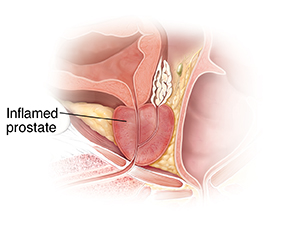Bacterial Prostatitis
Bacterial Prostatitis
The prostate gland is part of the male reproductive system. The gland sits just below the bladder. It surrounds the urethra, the tube that carries urine and semen out of the body. Bacterial prostatitis is an infection of the prostate. It causes the prostate to become painful and swollen. The problem often comes on suddenly, and can make you very sick. But it can be treated.
| |
|
Causes and symptoms
Bacterial prostatitis is due to infection with bacteria (germs). This infection makes the prostate swell. This squeezes the urethra, narrowing or blocking it. Symptoms may be severe. They can include:
-
Fever and chills
-
Low back pain
-
Having to urinate often
-
Pain with urination
-
A less forceful urine stream
-
Need to strain to urinate
-
Inability to urinate
Treatment
The infection is treated with antibiotics. Take all of the medicine until it's gone, even if you start to feel better. If you don’t, the infection may come back and be harder to treat. Your healthcare provider may also suggest other care, such as resting and drinking more fluid. Closely follow any instructions you are given.
Chronic bacterial prostatitis
Prostatitis can turn into a chronic (ongoing) problem. In this case, the prostate stays swollen and inflamed despite treatment with antibiotics. One possible cause is repeated infections. Symptoms include pain and burning with urination and needing to urinate often. It may also cause lower abdomen or back pain. If you have this problem, your healthcare provider will discuss a treatment plan with you. Treatment usually consists of a 6 to 12 week course of antibiotics.
Updated:
March 16, 2019
Sources:
Nickels, C., Treatment of chronic prostatitis/chronic pelvicpain syndrome, International Journal of Antimicrobial Agents (2008); 31; 112-116, Prostatitis: Diagnosis and Treatment. Sharp, V. American Family Physician. 2010, is. 82, ed. 4, pp. s397-406.
Reviewed By:
Marc Greenstein MD

